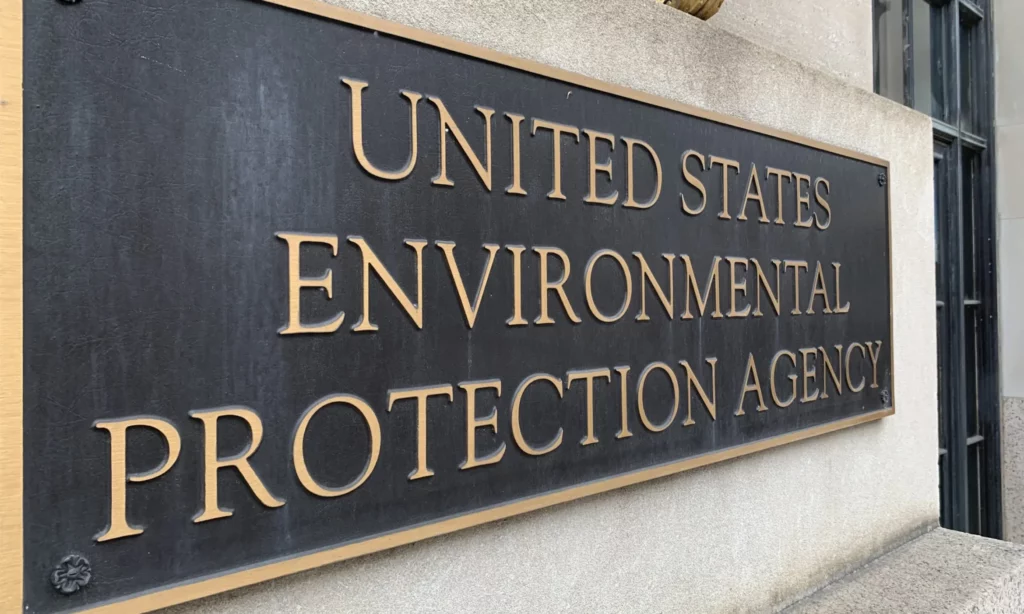The Environmental Protection Agency headquarters in Washington, D.C., in March 2024 (Lyle Muller/Investigate Midwest).
Imagine an agricultural chemical so vial, so poisonous, so unsafe to human health that even the pesticide-friendly and herbicide-happy Environmental Protection Agency eventually couldn’t look the other way.
That chemical is dimethyl tetrachloroterephthalate, also known as DCPA, sold under the brand name Dachtal. The herbicide is widely used on broccoli, cabbage, brussels sprouts, and onion crops in the U.S.
Just one company manufactures DCPA, AMVAC Chemical Corporation. But not anymore after AMVAC and EPA couldn’t agree on a new product warning label to address what the federal agency calls “an imminent hazard” in its emergency order to suspend registration:
“…current uses of DCPA may expose pregnant individuals to levels of the pesticide sufficient to cause adverse thyroid effects — with attendant lifelong health problems — in the fetuses of those individuals. There are still risk concerns even when taking into consideration the subsequent December 2023 product cancellations, the July 2023 voluntary use cancellation requests, and the registrant’s voluntary cessation of the sale and distribution of DCPA.”
The effects on fetuses can include low birth weight, impaired brain development, decreased bone deposition and Intelligence Quotient, and impaired motor skills.
EPA’s emergency order is all encompassing:
“Effective immediately, no person in any state may distribute, sell, offer for sale, hold for sale, ship, deliver for shipment, or receive and (having so received) deliver or offer to deliver to any person any pesticide product containing DCPA. Additionally, in accordance with FIFRA section 6(a)(1), EPA has elected not to permit the continued use of existing stocks, consistent with its policies applicable to cancellations where the Agency has identified significant risk concerns.”
We shouldn’t be throwing EPA flowers even though it’s the first time the agency has used an emergency order since banning DDT more than four decades ago.
Why? Because EPA failed to apply balanced science to prior registrations of DCPA and treated AMVAC with kid gloves.
Here’s the story.
DCPA was first registered in 1958 under the 1947 Federal Insecticide, Fungicide, and Rodenticide Act. Responsibility for administering FIFRA moved from USDA to the newly created EPA in 1970, and, in 1972, the act was amended adding new environmental and health standards as well as requiring re-registration of older pesticides.
But it wasn’t until 1988 that President Ronald Reagan signed amendments to the FIFRA that clarified pesticide and herbicide re-registration of products first registered before 1984 — including DCPA.
Even so, it was another seven years before EPA re-registered DCPA in 1995 for more than 80 products primarily used to control weeds on ornamental turf and plants, strawberries, seeded and transplanted vegetables, cotton, and field beans. As an aside, the re-registration did not include the original turf application because EPA wasn’t sure if DCPA could cause groundwater contamination as well as the possibility of “carcinogenic risk to children playing on lawns.”
But the dangers of DCPA were quickly coming into focus. In 1999, EPA found DCPA caused thyroid tumors in female and male rats and mice as well as liver tumors in mice and concluded:
“Further experimental work is needed to help determine modes of action of pesticides. More than one mode of action may apply; methods are available to discern each of them. Future studies submitted to the EPA are expected to comply with EPA science policy. Given the present assessment of pesticides as well as an evaluation of other chemicals, it is apparent that antithyroid activity is a common mode of thyroid carcinogenic action in rodents.”
While EPA was of the mind that additional information was necessary, it wasn’t until 2013 that it finally got around to demanding AMVAC provide more information on the herbicide. More than a decade after EPA’s own toxicological study. EPA gave AMVAC until January 2016 to submit roughly 20 studies on DCPA, including one examining thyroid hormone impacts.
But the chemical company dragged its feet on numerous reports and stonewalled the agency on others. EPA also found some studies insufficient to answer its concerns. The thyroid hormone study didn’t show up on EPA’s doorstep until August 2022 — more than six years after the deadline.
EPA could have and should have played hardball with AMVAC. Just how ridiculous was EPA oversight? In June 2022, EPA lead environmental protection specialist Jill Bloom filed a written court statement testifying about AMVAC’s radio silence:
“AMVAC’s actions as to the [data call-in] are abnormally dilatory and repetitive. Following EPA’s denial of AMVAC’s requests to waive certain data requirements, AMVAC followed up with additional waiver requests, which usually provided rationales similar to the originals, often with only minor or insignificant changes. In some cases, AMVAC simply opposed the Agency’s denials and did not offer any additional, substantive rationale. During this cycle of waiver requests and denials, AMVAC did not initiate attempts to satisfy the subject data requirements. In my experience, this cycle of repeated waiver requests is not common for other registrants and registration review cases. Additionally, explicit statements like AMVAC’s that it did not intend to submit certain data required by the DCI are not typical of registrants in general.”
AMVAC has delayed providing EPA information for years. And EPA dragged its feet asking AMVAC for information, and failed to hold the chemical company’s feet to the fire in a timely fashion when it missed deadlines and turned in shoddy work. For anyone who has followed the pesticide/herbicide re-registration process, this isn’t surprising.
I’m glad DCPA is headed off the market, although I’ll be the first to say AMVAC’s next move could include a lawsuit. And I’ll gladly pay a little bit more for my veggies should it come to that. But I’ve got to say EPA — the public deserves better.
This article first appeared on Investigate Midwest and is republished here under a Creative Commons license.

